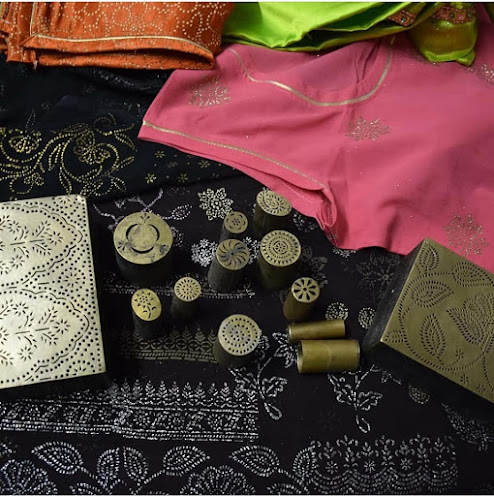Khari printing is a technique in which a paste is used which is
pushed through a metal container with a specific design cut out from its
base leaving that design on the fabric. Gold and Silver dust is
sprinkled over the printed fabric creating a highlight or a single
design in its own right.
It is a highly skilled and labour-intensive process with only a small
motif produced by each impression. The process starts with the
specially prepared roghan gum paste made of a cooked mixture of castor
oil that has been processed through repeated boiling till it forms a
thick, viscous, gooey mass. It is followed by the addition of other
ingredients that include turpentine, further heated, thickened and
strained till the paste achieves the acceptable printing consistency.The
stamping tools used in Khari printing are also different from other
forms of block printing.
 |
| Sancha (Blocks) |
An ingenuous system, it uses two different blocks. The outer metal case
is made of brass. The design is perforated onto the surface of its base.
The inner component of the case is the wooden mallet, fitting perfectly
into the metal sleeve. The karigar forces the thick viscous roghan
paste through the perforation to form the motif on the textile. This is
only the first phase in the printing process. |
Hatha (Mallet) and Sancha in action
|
While the roghan paste has not yet set, metal powders or mica abrakh
powders are dusted on the fabric. When dried any excess powder is
removed and saved for further use, while the glittering textile is ready
for use.A wide range of motifs can be created, the only constraint in
Khari work being that the patterns be fashioned of smallish dots and
dashes as long and heavy lines or filled motifs stiffen the surface
reducing drapability. The finished product replicates the luxury of
metal thread embroidery. Dry cleaning should be avoided in Khari
printing. The stamping tools used in Khari printing are different from other forms of block printing. It uses two different blocks, close fitted to each other like a glove. The outer sancha metal case is made of brass. The inner component is a wooden mallet which perfectly fits into the metal sleeve.Here's the process
1. Rogan gum paste is prepared from a mixture of castor oil that has been processed through repeated boiling till it forms a thick viscous gooey mass.
2. This is followed by addition of other ingredients including turpentine. The printing consistency is achieved by heating, thickening and staining this mixture.
3. The metal case is filled with the rogan paste and the wooden mallet pushes the paste to form a motif. This is initially tested on a paper to check consistency.
4. The Rogan paste is printed over the fabric.
5. While the paste hasn't set yet, metal powders are dusted on it.
6. The excess dust is now removed and fabric is dried for two days after which it is ready to use.
 |
| The Process |
 |
Saree done using Khari Printing Technique
|





Comments
Post a Comment